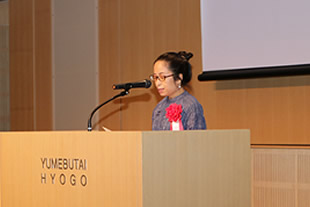 The 22nd Asia Pacific Research Prize - Commendation winner: Dr. Nguyen Thi Le
The 22nd Asia Pacific Research Prize - Commendation winner: Dr. Nguyen Thi Le
Title of Dissertation: “Childbirth among Ethnic Minority People in Northern Vietnam: Choice and Agency in the Hmong Case”

- Dr. Nguyen Thi Le
-
- Career -
Nguyen Thi Le is an anthropologist specializing in the ethnicity and culture of ethnic groups in Vietnam, especially the Hmong. She has been working as a researcher at the Institute of Human Studies, Vietnam Academy of Social Sciences since 2011. She received her B.A and M.A. at the University of Social Sciences and Humanities, Vietnam. In 2015, she got a Japanese Government (MEXT) Scholarship to do PhD in Japan. Since 2016, she has conducted ethnographic fieldwork in the Dong Van Karst Plateau, northeast Vietnam, and based on this research, she received her PhD from the Graduate School of Asian and African Area Studies (ASAFAS), Kyoto University in 2020.
- Summary -
This dissertation is a study of the birth practices among Hmong minorities in the mountains of northern Vietnam in a period of transition in modern history. Taking into account the voices of the local population, this study examines and interprets how and why the Hmong minorities make a choice between alternatives during childbirth in specific political and social climates. The research is represented in 7 chapters. Chapter 1 provides the background of the study, research questions, literature review, theoretical framework, and research methodology. Chapters 2 and 3 describe the macro contexts that influence the birth practices of the ethnic minorities and the Hmong in the two northern mountain villages. Since ethnicity is the focus of the argument, this study pays special attention to the macro-contexts of ethnic relationships that formulate the so-called "ethnic minorities" and the consequences of such a status quo. Chapter 3 focuses on reproductive health problems among ethnic minorities in Vietnam, from the common discourses to the interventions. Chapter 4 explores how the Hmong live as a micro-context on the ground. Chapter 5 contributes to an ethnography of birth in the Hmong traditional way, and Chapter 6 investigates childbirth practices among the Hmong in two villages in the context of medical pluralism. Statistical analyses and women's statements on birth decisions are used to provide the real picture of childbirth practices and the factors that influence those choices. Chapter 7 presents discussions and conclusions based on data and analysis of all chapters. Drawing from the theoretical framework and research findings, this chapter clarifies the local population's agency in the process of choosing birth practices and discusses issues related to ethnicity and civilizing projects, as well as the implication of the study on childbirth and reproductive health among ethnic minorities in Vietnam.The results of this study show that in the context of the interaction between biomedical/modern care and ethnomedical care, Hmong people in the two studied villages have utilized obstetric care options from both the ethnomedical system and the national health care system in a flexible, pragmatic, eclectic and syncretic way. The healthcare patterns used by Hmong women during childbirth are dynamic, reflecting the complex interaction of many factors, such as distance, cost, quality of care, culture, and the agency of social actors. The Hmong exercise agency to make their best choices in childbirth which can balance all relevant factors and ensure the ultimate goal: the safety of mother and child. Ethnography can show that the Hmong are not completely determined by the so-called "cultural factor" or by "structural violence", but have significant agency in decision-making during childbirth.






